
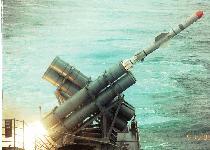
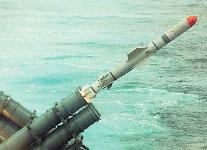
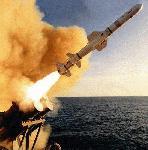
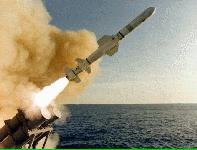
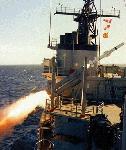
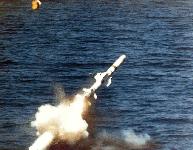

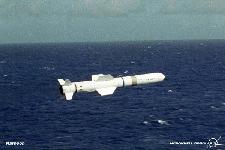

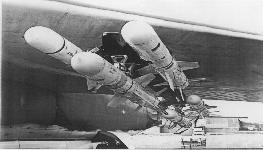
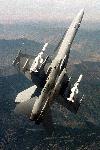
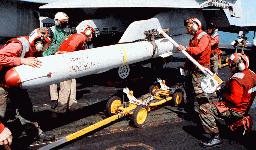
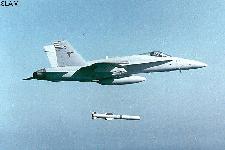




The Harpoon missile provides the Navy and the Air Force with a common missile for air, ship, and submarine launches. The weapon system uses mid-course guidance with a radar seeker to attack surface ships. Its low-level, sea-skimming cruise trajectory, active radar guidance and warhead design assure high survivability and effectiveness. The Harpoon missile and its launch control equipment provide the warfighter capability to interdict ships at ranges well beyond those of other aircraft.
The Harpoon missile was designed to sink warships in an open-ocean environment. Other weapons (such as the Standard and Tomahawk missiles) can be used against ships, but Harpoon and Penguin are the only missiles used by the United States military with anti-ship warfare as the primary mission. Once targeting information is obtained and sent to the Harpoon missile, it is fired. Once fired, the missile flys to the target location, turns on its seeker, locates the target and strikes it without further action from the firing platform. This allows the firing platform to engage other threats instead of concentrating on one at a time.
An appropriately configured HARPOON can be launched from an AERO-65 bomb rack, AERO-7/A bomb rack, MK 6 canister, MK 7 shock resistant canister, MK 12 thickwall canister, MK 112 ASROC launcher, MK 8 and MK 116 TARTAR launcher, or submarine torpedo tube launcher.
Submarines fire a capsule containing the Harpoon from their torpedo tubes. When the capsule breaches the surface, the top is blown off and the missile is launched. Aircraft launched Harpoons do not require a Booster. Depending upon launch conditions, the Harpoon engine generally will not start until after the missile is dropped from the wing. This allows firing from higher altitudes and longer range flights.
The Guidance Section consists of an active radar seeker and radome, Missile Guidance Unit (MGU), radar altimeter and antennas, and power converter. The MGU consists of a three-axis attitude reference assembly (ARA) and a digital computer/power supply (DC/PS). Prior to launch, the DC/PS is initialized with data by the Command Launch System. After launch, the DC/PS uses the missile acceleration data from the ARA and altitude data from the radar altimeter to maintain the missile on the programmed flight profile. After seeker target acquisition, the DC/PS uses seeker data to guide the missile to the target. The Warhead Section consists of a target-penetrating, load-carrying steel structure containing 215 pounds of high explosive (DESTEX) and a safe-and-arm/contact fuze assembly. The safe-and-arm/contact fuze assembly ensures the warhead will not explode until after the missile is launched. It is designed to explode the warhead after impacting the target. The warhead section can be replaced by an exercise section which transmits missile performance data for collection and analysis. The Sustainer Section consists of a fuel tank with JP-10 fuel, air inlet duct, and a jet engine. This provides the thrust to power the missile during sustained flight. The Sustainer Section has four fixed fins which provide lift. The Control Section consists of four electromechanical actuators which use signals from the Guidance Section to turn four fins which control missile motion. The Booster Section consists of a solid fuel rocket and arming and firing device. Surface and submarine platforms use a booster to launch Harpoon and propel it to a speed at which sustained flight can be achieved. The Booster Section separates from the missile before sustained flight begins.The submarine Harpoon is contained within a capsule and is called ENCAP for encapsulated. The ENCAP is the same size and general shape of a blunt nosed torpedo and is launched from submarine torpedo tubes. It has positive buoyancy (it floats), so when it is ejected from the submarine, it will rise to the surface, without power. The ENCAP consists of a nosecap, main body and afterbody. The missile is on shock isolator rails within the main body. The afterbody has fins which direct the ENCAP towards the surface at the proper angle for missile launch. Once the ENCAP breaches the surface, the nosecap is blown off by a small rocket and the missile is launched.
The Harpoon missile was developed in the early 1970s. Numerous upgrades have kept it at the forefront of missile capabilities, including the Block 1 introduced in 1978, and the Block 1B introduced in 1981. Today, the latest variant developed in 1982 called Block 1C is deployed by the United States military (Navy and Air Force) as well as US allies. New developments are constantly being evaluated. Although originally planned to be in use until 2015, there is no plan to develop a replacement by the USN. There are continuing, extensive efforts (testing and analysis) to ensure no detrimental effects of missile aging. With budget constraints projected into the future, Harpoon will be employed past 2015.
The AGM-84D Harpoon is an all-weather, over-the-horizon, anti-ship missile system produced by Boeing [formerly McDonnell Douglas]. The Harpoon's active radar guidance, warhead design, and low-level, sea-skimming cruise trajectory assure high survivability and effectiveness. The missile is capable of being launched from surface ships, submarines, or (without the booster) from aircraft. The AGM-84D was first introduced in 1977, and in 1979 an air-launched version was deployed on the Navy's P-3 Orion aircraft. Originally developed for the Navy to serve as its basic anti-ship missile for fleetwide use, the AGM-84D also has been adapted for use on the Air Force's B-52G bombers, which can carry from eight to 12 of the missiles.
The AGM-84D Harpoon Block 1D (with a larger fuel tank and reattack capability) was developed in 1991. With the reduced threat because of the break-up of the Soviet Union, this upgrade was shelved and never produced.
The AGM-84E Harpoon/SLAM [Stand-Off Land Attack Missile] Block 1E is an intermediate range weapon system designed to provide day, night and adverse weather precision strike capability against high value land targets and ships in port. In the late 1980s, a land-attack missile was needed. Rather than design one from scratch, the US Navy took everything from Harpoon except the guidance and seeker sections, added a Global Positioning System receiver, a Walleye optical guidance system, and a Maverick data-link to create the Stand-off Land Attack Missile (SLAM). The AGM-84E uses an inertial navigation system with GPS, infrared terminal guidance, and is fitted with a Tomahawk warhead for better penetration. SLAM can be launched from land-based or aircraft carrier-based F/A-18 Hornet aircraft. It was employed successfully in Operation Desert Storm and UN relief operations in Bosnia prior to Operation Joint Endeavor.
The SLAM-ER (Expanded Response) Block 1F, a major upgrade to the SLAM missile that is currently in production, provides over twice the missile range, target penetration capability, and control range of SLAM. SLAM-ER has a greater range (150+ miles), a titanium warhead for increased penetration, and software improvements which allow the pilot to retarget the impact point of the missile during the terminal phase of attack (about the last five miles). In addition, many expansions are being made to improve performance, survivability, mission planning, and pilot (man-in-the-loop) interface. The SLAM-ER development contract was awarded to McDonnell Douglas Aerospace (Now BOEING) in February of 1995. SLAM-ER achieved its first flight in March of 1997. All Navy SLAM missiles are currently planned to be retrofitted to SLAM-ER configuration. About 500 SLAM missiles will be converted to the SLAM-ER configuration between FY 1997 and FY 2001.
The SLAM-ATA (Automatic Target Acquisition) Block 1G, a follow on enhancement to SLAM-ER with reattack capability and new seeker, is under development. SLAM-ERs equipped with ATA will match the seeker images of a target scene with an on-board reference image. This process will improve the missile's ability to strike targets in cluttered spaces, such as urban areas. It will also improve missile targeting capability in poor weather, counter measure protected environments, and better enable offset aimpoint targeting.
The Harpoon Block II is an upgrade program to improve the baseline capabilities to attack targets in congested littoral environments. The upgrade is based on the current Harpoon. Harpoon Block II will provide accurate long-range guidance for coastal, littoral and blue water ship targets by incorporating the low cost integrated Global Positioning System/Inertial Navigation System (GPS/INS) from the Joint Direct Attack Munitions (JDAM) program currently under development by Boeing. GPS antennae and software from Boeing's Standoff Land Attack Missile (SLAM) and SLAM Expanded Response (SLAM ER) will be integrated into the guidance section. The improved littoral capabilities will enable Harpoon Block II to impact a designated GPS target point. The existing 500 pound blast warhead will deliver lethal firepower against targets which include coastal anti-surface missile sites and ships in port. For the anti-ship mission, the GPS/INS provides improved missile guidance to the target area. The accurate navigation solution allows target ship discrimination from a nearby land mass using shoreline data provided by the launch platform. These Block II improvements will maintain Harpoon's high hit probability while offering a 90% improvement in the separation distance between the hostile threat and local shorelines. Harpoon Block II will be capable of deployment from all platforms which currently have the Harpoon Missile system by using existing command and launch equipment. A growth path is envisioned for integration with the Vertical Launch System and modern integrated weapon control systems. With initiation of engineering and manufacturing development in 1998, initial operational capability for Block II will be available by 2001.
At the direction of Headquarters Strategic Air Command, the Harpoon Air Command and Launch Control Set was fully integrated into a fully operational B-52G from Mather AFB, Calif., in March 1983. Three successful live launches at the Naval Air Warfare Center, Point Mugu, Calif., led to the modification of a total of 30 B-52Gs with Harpoon launch control equipment, enough to provide two squadrons of Harpoon-capable B-52Gs by June 30, 1985. The 42nd Bombardment Wing, Loring Air Force Base, Maine, and the 43rd Bombardment Wing, Andersen Air Force Base, Guam, were first tasked to perform the Harpoon mission. Both wings refined tactics and doctrine to merge the long-range, heavy-payload capability of the B-52 with the proven reliability of this superior stand-off attack weapon.
After Loring AFB closed and the retirement of the last B-52G at Castle AFB, Calif., the Harpoon mission was moved to the 2nd Bomb Wing at Barksdale AFB, La. Four B-52H models were rapidly modified (as an interim measure) to accept Harpoon launch control equipment pending B-52H fleet modification. By 1997, all B-52H airframes were Harpoon capable, providing both the 5th Bomb Wing at Minot AFB, N.D., and the 2nd Bomb Wing at Barksdale, full squadron strength capability.
Following five successful flight tests and the completion of developmental tests, in early 1998 the US Navy approved the second low-rate initial production lot of the Boeing Standoff Land Attack Missile Expanded Response. The decision paved the way for Boeing to produce 22 SLAM ERs with an option for an additional 20. Interim flight clearance was granted by Commander Naval Air Systems Command for employment of SLAM ER AGM-84H missiles on F/A-18C/D aircraft in two configurations:The Navy has proposed replacing the joint program for JASSM with SLAM-ER, prior to completion of the current program definition and risk reduction phase for JASSM. However, the SLAM-ER development and procurement schedule may be excessively concurrent. On the basis of a single controlled flight test, the Navy made a low rate initial production decision that will result in the procurement of approximately 19 percent of the total planned buy of SLAM-ER before the completion of development and operational testing. And flight tests of a SLAM-ER with operational seeker will not be conducted until Development Test II.
The Harpoon missile launcher can be mounted on a truck. Another truck holds the Command Launch System electronics and a generator. Park the two trucks, connect them with cables, and the anti-ship missile battery is ready to control straits or prevent ships from threatening friendly soil.
Specifications | ||||
| Primary Function: | Air-to-surface anti-ship missile | |||
| Mission | Maritime ship attack | |||
| Targets | Maritime surface | |||
| Service | Navy and Air Force | |||
| Contractor: | Boeing [ex McDonnell Douglas] | |||
| Power Plant: | Teledyne Turbojet and solid propellant booster for surface and submarine launch | |||
| Program status | Operational | |||
| sea-launch | air-launch | SLAM | SLAM-ER | |
| First capability | 1977 | 1979 | ||
| Thrust: | 660 pounds | |||
| Length: |
15 feet (4.55 meters) |
12 feet, 7 inches (3.79 meters) |
14 feet, 8 inches (4.49 meters) | |
| Weight: |
1,470 pounds (661.5 kilograms) |
1,145 pounds (515.25 kilograms) |
1,385 pounds (629.55 kilograms) | |
| Diameter: | 13.5 inches (34.29 centimeters) | |||
| Wingspan: | 3 feet (91.44 centimeters) | |||
| Range: | Greater than 60 nautical miles | 150+ miles | ||
| Speed: | 855 km/h | |||
| Guidance System: | Sea-skimming cruise with mid-course guidance monitored by radar altimeter, active seeker radar terminal homing | inertial navigation system with GPS, infrared terminal guidance | ||
| Warheads: | Penetration high-explosive blast (488 pounds) | |||
| Explosive | Destex | |||
| Fuze | Contact | |||
| Development cost | $320.7 million | |||
| Production cost | $2,882.3 million | |||
| Total acquisition cost | $3,203.0 million | |||
| Acquisition unit cost | $527,416 | |||
| Production unit cost | $474,609 | |||
| Quantity | Navy: 5,983; Air Force: 90 | |||
| Platforms | A-6, F/A-18, S-3, P-3, B-52H, ships | |||














